⎯ A route for the element to move from the assembly area to the first firing point without damaging the underground wiring.
• Firing area:
⎯ The TOW backblast area (75 meters by 90 degrees) will be clear.
⎯ Smoke may be used.
• Training aids, devices, and special equipment:
⎯ TFTT system.
⎯ Sufficient TFTT retroreflectors to cover targets. (Use of MILES harness and LTIDs is optional.)
• Ammunition: Ten M80 blast simulators per TOW, per iteration.
• Key references: FM 3-21.91(FM 7-91), FM 3-22.34(FM 23-34), and live-fire point calculation sheet.
(4)
Trainer/Evaluator Guidelines. Because this table is conducted on an MPRC, marking the firing positions may be necessary. At night, the roads must be marked with luminous tape.
b.
TOW Gunnery Table 6, Baseline TFTT Gunnery Qualification. TOW
Gunnery Table 6 is conducted according to the same conditions and standards as TOW
4-18
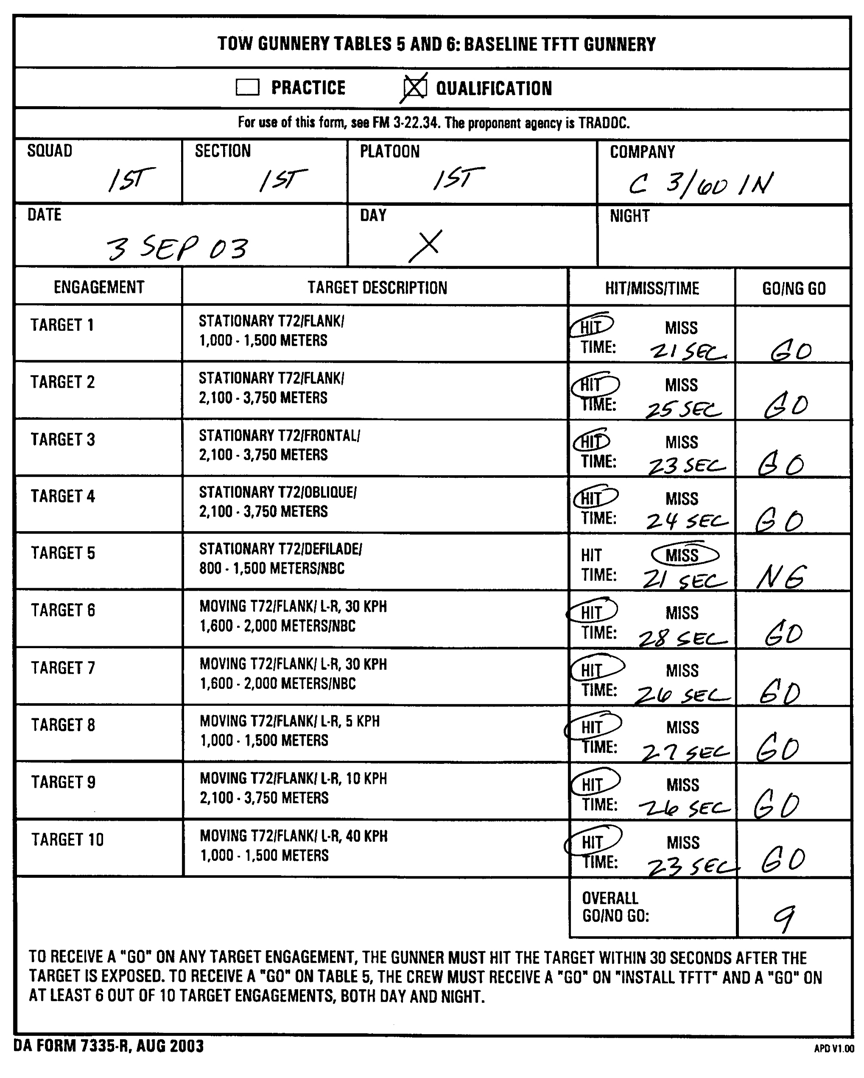
FM 3-22.34
Gunnery Table 5. DA Form 7335-R (TOW Gunnery Tables 5 and 6, Baseline TFTT
Gunnery Practice and Qualification Scorecard, Figure 4-6) is used to score the table.
Figure 4-6. Example of completed DA Form 7335-R,
TOW Gunnery Tables 5 and 6: Baseline TFTT Gunnery Practice
and Qualification.
4-19
FM 3-22.34
c.
TOW Gunnery Table 7, Squad Gunnery Practice. This table trains the TOW
squad to engage stationary and moving targets in a simulated battlefield scenario (Figure 4-7, page 4-22). It prepares the TOW squad for TOW Gunnery Table 8, Squad Gunnery Qualification, by presenting engagement scenarios and task requirements similar to those for evaluation. TOW Gunnery Table 7 may be conducted by a TOW
HMMWV on an MPRC light.
(1)
Conduct. All firings will be from the hull down position. Reload procedures will be executed from a defilade position. All stationary targets should be mounted on pop-up mechanisms to facilitate target acquisition and scoring. If pop-up mechanisms are not available, exposed stationary targets will be placed in an appropriate array. If exposed targets must be used, the exercise should be designed so that targets are presented only to the position from which they should be engaged. Moving targets should be presented at speeds from 5 to 40 kilometers per hour.
(2)
Scoring. The squad is rated based on the total point score. For scoring gunnery, time will start for the first target when the target is raised and will stop when the target is hit. All reloads will be made from a hull defilade position. Time for the second target begins when the vehicle reoccupies the firing position and ends when the target is hit. DA Form 7336-R (TOW Gunnery Table 7, Squad Gunnery Practice Scoresheet, Figure 4-8, page 4-23) will be used to record scores.
(a) The table consists of five tasks. Each task consists of one or more target engagements from one firing position. Each target engagement is worth a maximum of 100 points. The point score is determined by the time taken to kill the target using the live-fire point calculation sheet (Figure 4-16, page 4-35). Any crew or leader cuts are deducted from this score (Table 4-5, page 4-21 and Table 4-6, page 4-26).
(b) Each task is also worth a maximum of 100 possible points. This score is calculated by adding the scores for all engagements made during the task and dividing by the number of targets engaged. For example, three targets were engaged and the scores were 75, 82, and 93 for a total of 250 points divided by 3 (the number of targets presented) for a task score of 81 points.
(c) Each table is performed once during the day and once at night. Scoring for day engagements will be made by the evaluator in the range tower. Scoring for night engagements will be made by both evaluators. The scores of the two events are added together for a maximum possible score of 1,000 points. This is the final score for the gunnery table.
NOTE:
This scoring process is the same for Tables 7 through 12.
4-20
FM 3-22.34
CREW CUTS
MINOR
MAJOR
(Deduct 5 points)
(Deduct 30 points)
Improper fire commands.
Failure to conduct system self-
test/boresight before engaging
Firing before receiving
first target.
command to fire.
Failure to collimate day sight
Incorrect engagement
and or nightsight before
techniques (such as engaging
engaging first target.
the least dangerous target
before the most dangerous
Failure to be in MOPP4 and
target).
close all hatches during NBC
engagement.
Engagement of friendly targets
(if friendly targets are
presented).
Table 4-5. Crew cuts.
d.
TOW Gunnery Table 8, Squad Gunnery Qualification. TOW Gunnery Table 8
evaluates the TOW squad on its ability to engage stationary and moving targets in a simulated battlefield scenario (Figure 4-7, page 4-22). The conduct, scoring, suggested support requirements, and trainer/evaluator guidelines are the same as for TOW Gunnery Table 7. The squad’s scores will be recorded on DA Form 7337-R, (TOW Gunnery Table 8, Squad Qualification Scoresheet, Figure 4-9, page 4-24).
4-21
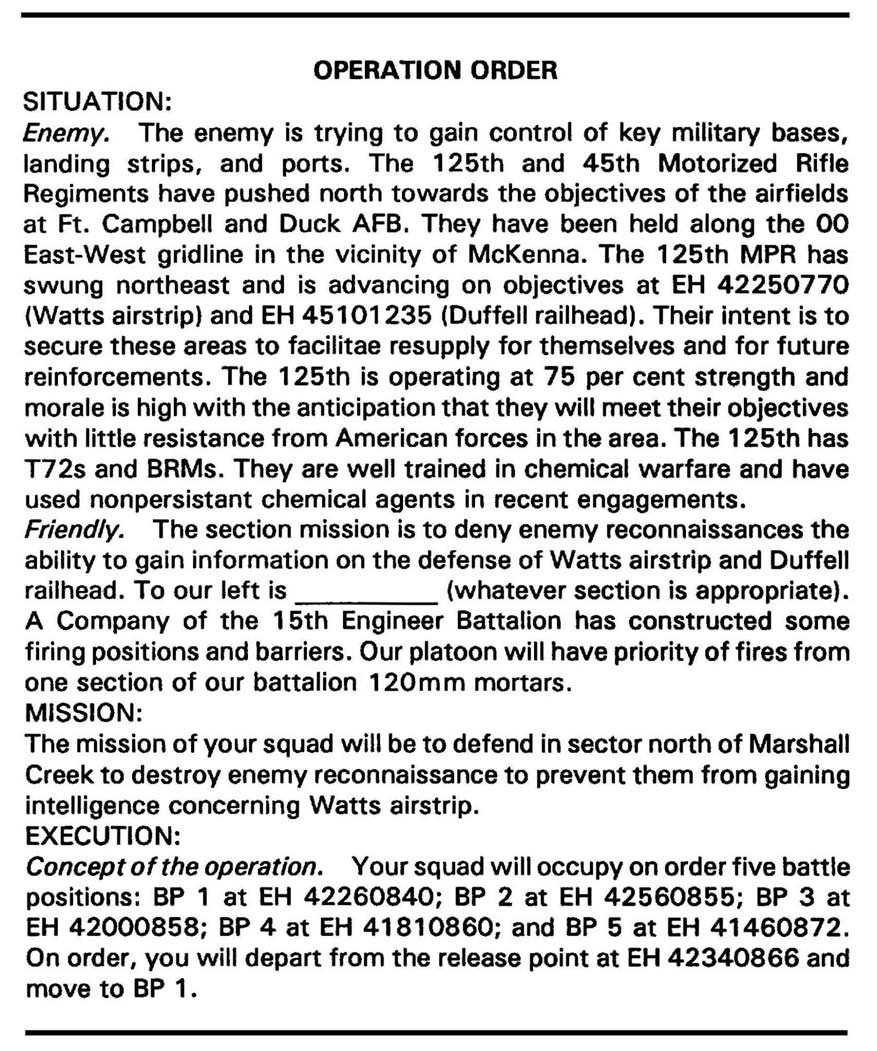
FM 3-22.34
Figure 4-7. Example squad gunnery practice and qualification scenario.
4-22
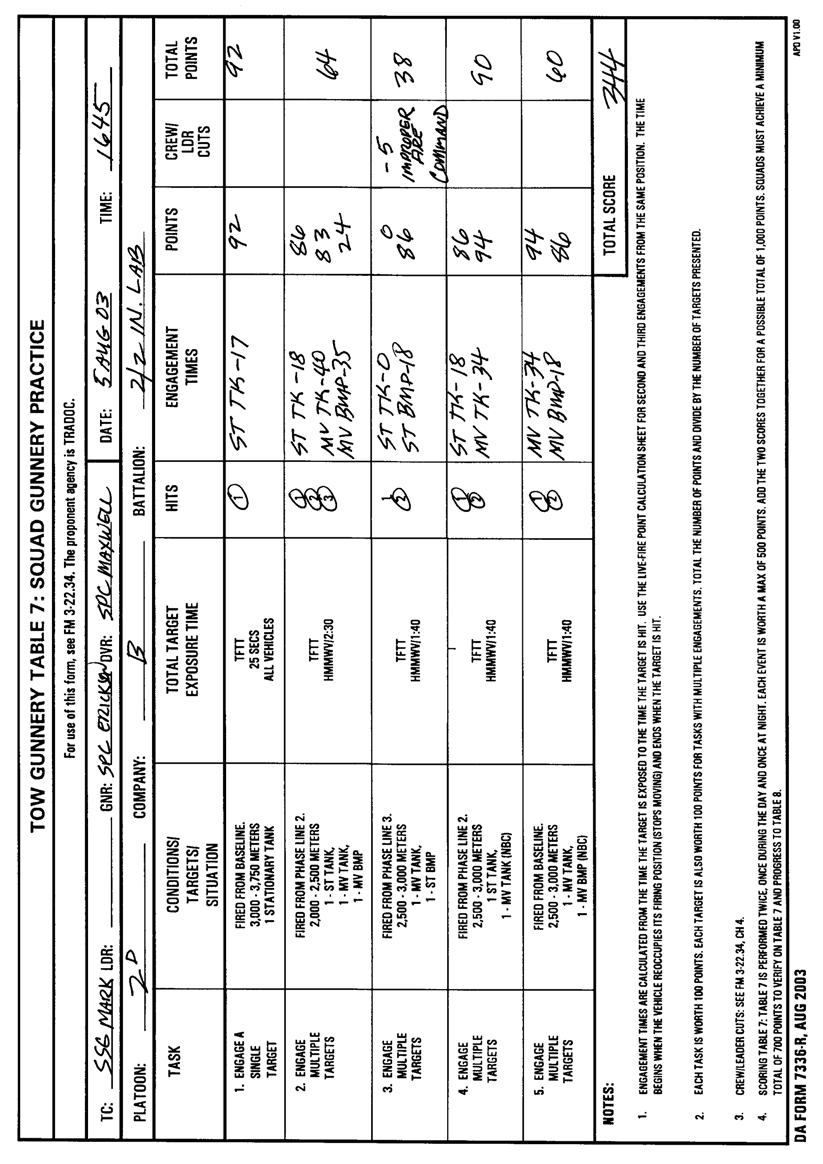
FM 3-22.34
Figure 4-8. Example of completed DA Form 7336-R,
TOW Gunnery Table 7: Squad Gunnery Practice.
4-23
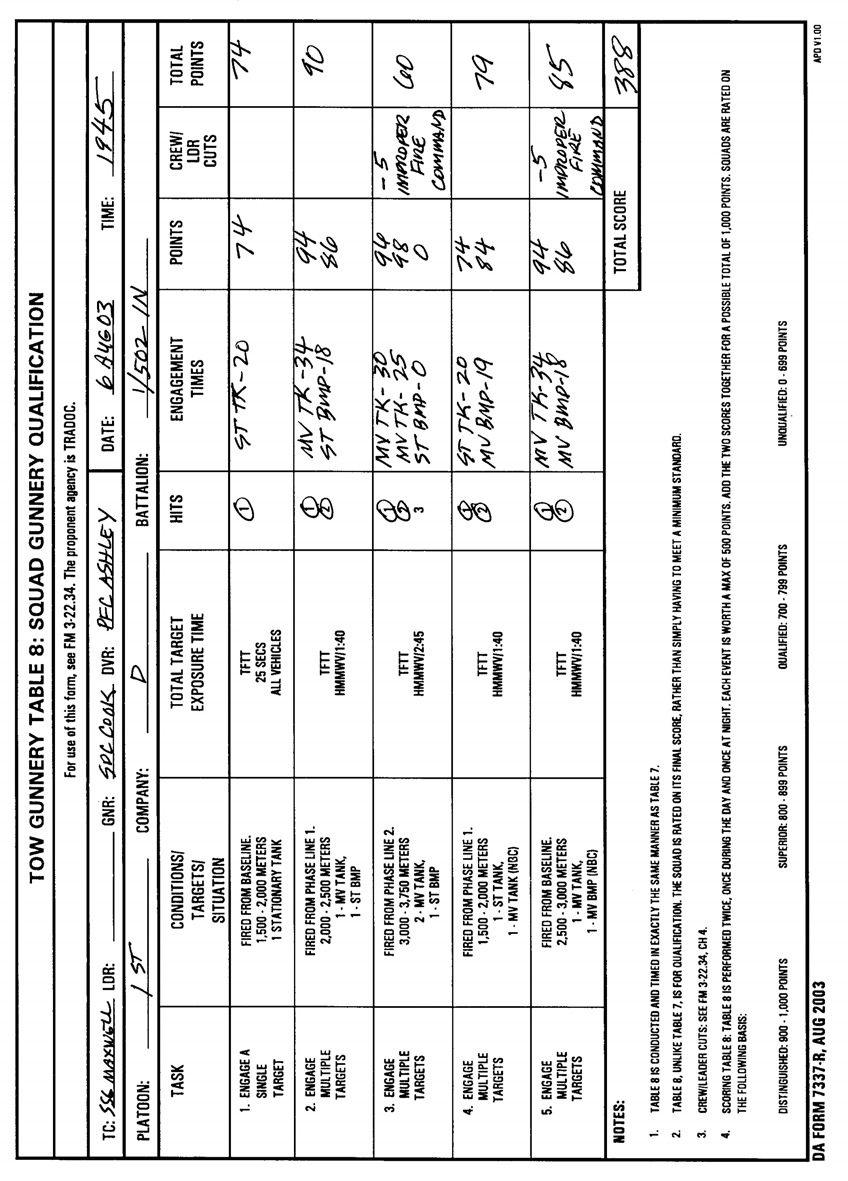
FM 3-22.34
Figure 4-9. Example of completed DA Form 7337-R,
TOW Gunnery Table 8: Squad Gunnery Qualification.
4-24
FM 3-22.34
4-9.
PHASE III: SECTION TRAINING
Phase III begins section-level TOW training. TOW Gunnery Tables 9 and 10 are moving gunnery exercises where the vehicle moves from point to point on a course and engages a series of targets. These gunnery exercises are used to train and evaluate the TOW unit’s combat capability. Each element has two tables: a practice table to train and a qualification table for evaluation. Each table is performed once during the day and once during the night under realistic (simulated) battlefield conditions. Point scores for target engagements are based on a combat model that predicts success based on the time from target detection to target engagement, type of target, and range to target. These scores are taken from the live-fire point calculation sheet (Figure 4-16, page 4-35). Point scores are also affected by crew cuts (crew cuts are crew errors, either major or minor, that reduce the point score for a target engagement). The actual rating is calculated by adding the scores for the day and night phases and dividing them by two to get an average score.
During move-out scenarios, the senior trainer is normally to the rear of the leader’s vehicle for evaluation and training purposes. An assistant evaluator of the appropriate rank and experience is normally assigned to each additional vehicle that is evaluated as part of the same exercise. Evaluators must monitor crew conversations and fire commands.
a.
TOW Gunnery Table 9, Section Gunnery Practice. This table trains the TOW
section to control fire and distribution. It contains offensive and defensive engagements in a simulated battlefield scenario (Figure 4-10, page 4-27). TOW Gunnery Table 9
prepares the TOW section for the qualification table by presenting engagement scenarios and task requirements similar to those for evaluation. It may be conducted by a TOW
HMMWV on an MPRC light.
(1)
Conduct. All firings will be from the hull down position. Reload procedures will be executed from a defilade position. All stationary targets should be mounted on pop-up mechanisms to facilitate target acquisition and scoring. If pop-up mechanisms are not available, exposed stationary targets will be placed in an appropriate array. If exposed targets must be used, the exercise should be designed so that targets are presented only to the position from which they should be engaged. Moving targets should be presented at speeds from 5 to 40 kilometers per hour.
(2)
Scoring. The section is rated based on the total point score accumulated. For scoring gunnery, times for engagements will be scored separately for each vehicle. Start time for the section leader’s vehicle will be the same as in TOW Gunnery Table 7. Start time for the squad leader’s vehicle will be upon completion of the fire directive by the section leader, which will include the method of engagement. Stop time will be when the target is hit. Points will be awarded IAW the live-fire point calculation sheet (Figure 4-16, page 4-35). Deductions will be made from this point score when a major or minor crew cut error (Table 4-5, page 4-21) or a section leader cut error (Table 4-6, page 4-26) is made. The evaluator in the range tower will score day engagements. Both evaluators will score night engagements. DA Form 7338-R (TOW Gunnery Table 9, Section Gunnery Practice Scoresheet, Figure 4-11, page 4-28) will be used to record the scores.
4-25
FM 3-22.34
LEADER CUTS
MINOR
MAJOR
(Deduct 10 points)
(Deduct 30 points)
Give incorrect fire commands.
⎯ Fail to properly distribute
and control section fires.
Fail to give SITREP to tower.
Table 4-6. Section leader cuts.
(3)
Suggested support requirements. The following support requirements are recommended when conducting TOW Gunnery Tables 9 and 10.
• Minimum evaluators (evaluators will not assist the gunner in finding or identifying targets):
⎯ One evaluator per section and squad.
⎯ Two evaluators in the range tower to record scores on engagements.
• Opposing forces: None.
• Support troops: None.
• Vehicles/communications:
⎯ One AN/PRC-119 radio per section and squad evaluator.
⎯ Two AN/PRC-119 radios for the tower evaluator (one primary, one spare).
⎯ Two frequencies (one for the tower and section evaluator and one for the antiarmor squad).
• Maneuver area:
⎯ Multipurpose range complex.
⎯ A route for the element to move from the assembly area to the first firing point without damaging the underground wiring.
• Firing area:
⎯ The TOW backblast area (75 meters by 90 degrees) will be clear.
⎯ Smoke may be used.
• Training aids, devices, and special equipment:
⎯ TFTT system.
⎯ Sufficient TFTT retroreflectors to cover the targets. (Use of MILES
harness and LTIDs is optional.)
• Ammunition: Six M80 blast simulators per TOW, per iteration.
• Key references: FM 3-21.91(FM 7-91), FM 3-22.34(FM 23-34), and live-fire point calculation sheet.
(4)
Trainer/Evaluator Guidelines. Because this table is conducted on an MPRC, marking the firing positions may be necessary. At night, the roads must be marked with luminous tape.
b.
TOW Gunnery Table 10, Section Gunnery Qualification. TOW Gunnery Table 10 evaluates the TOW section on controlling fire and distribution. It contains offensive and defensive engagements in a simulated battlefield scenario (Figure 4-10, page 4-27).
The conduct, scoring, suggested support requirements, and trainer/evaluator guidelines are the same as for TOW Gunnery Table 9. The section’s scores will be recorded on 4-26
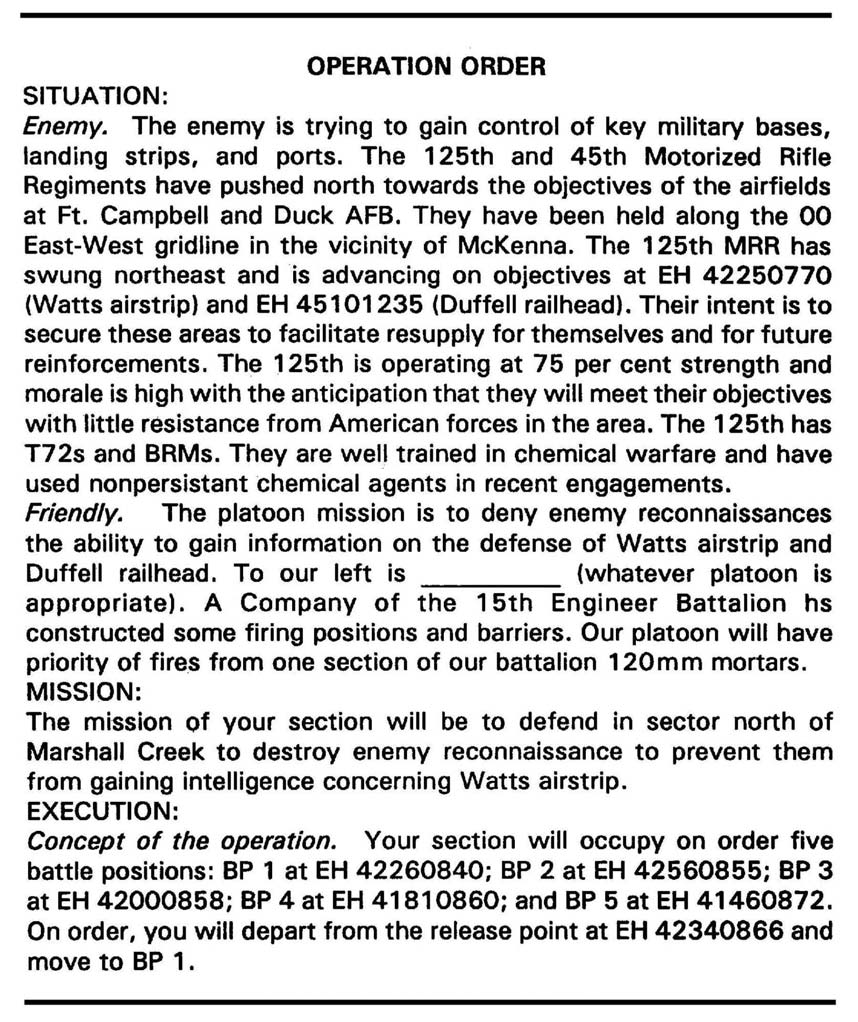
FM 3-22.34
DA Form 7339-R (TOW Gunnery Table 10, Section Gunnery Qualification Scoresheet, Figure 4-12, page 4-29).
Figure 4-10. Example section gunnery practice and qualification scenario.
4-27

FM 3-22.34
Figure 4-11. Example of completed DA Form 7338-R,
TOW Gunnery Table 9: Section Gunnery Practice.
4-28
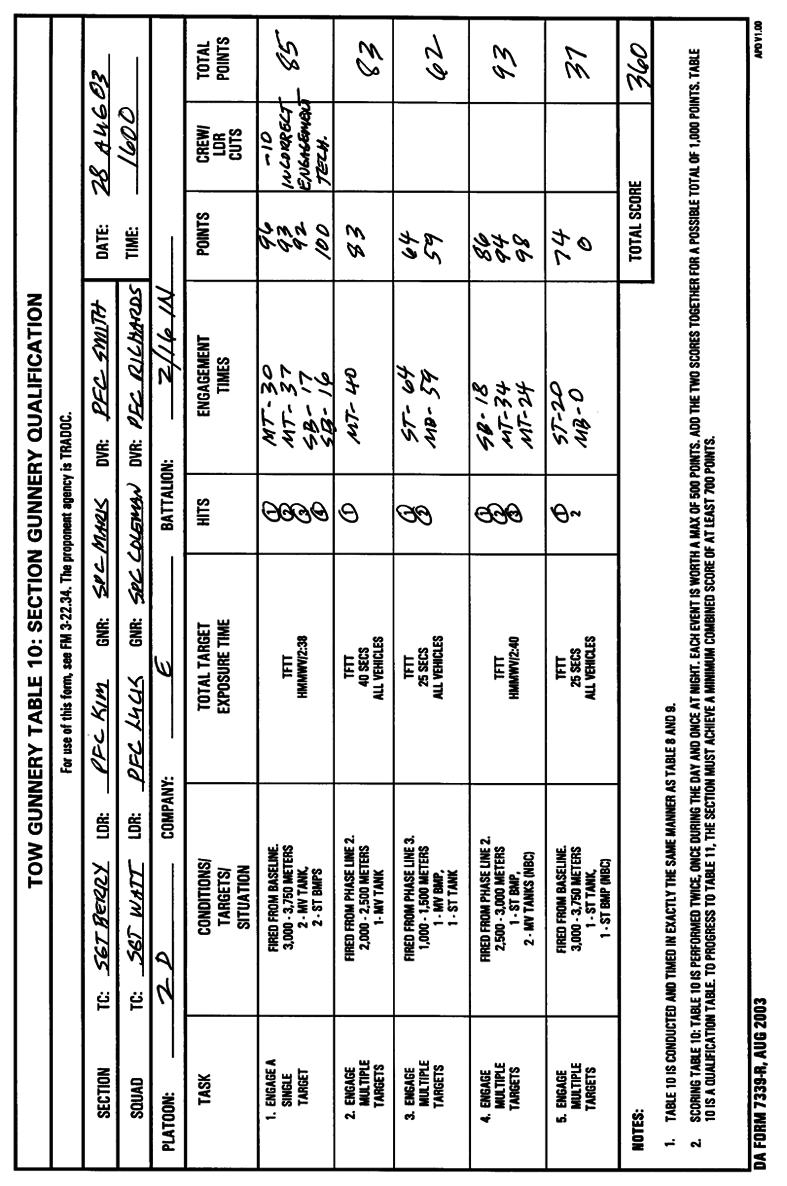
FM 3-22.34
Figure 4-12. Example of completed DA Form 7339-R,
TOW Gunnery Table 10: TOW Section Gunnery Qualification.
4-29
FM 3-22.34
4-10. PHASE IV: PLATOON TRAINING
Phase IV begins platoon-level TOW training. TOW Gunnery Tables 11 and 12 are moving gunnery exercises where the vehicle moves from point to point on a course and engages a series of targets. These gunnery exercises are used to train and evaluate the TOW unit’s combat capability. Each element has two tables: a practice table to train and a qualification table for evaluation. Each table is performed once during the day and once during the night under realistic (simulated) battlefield conditions. Point scores for target engagements are based on a combat model that predicts success based on the time from target detection to target engagement, type of target, and range to target. These scores are taken from the live-fire point calculation sheet (Figure 4-16, page 4-35). Point scores are also affected by crew cuts (crew cuts are crew errors, either major or minor, that reduce the point score for a target engagement). The actual rating is calculated by adding the scores for the day and night phases and dividing them by two to get an average score.
During move-out scenarios, the senior trainer is normally to the rear of the leader’s vehicle for evaluation and training purposes. An assistant evaluator of the appropriate rank and experience is normally assigned to each additional vehicle that is evaluated as part of the same exercise. Evaluators must monitor crew conversations and fire commands.
a.
TOW Gunnery Table 11, Platoon Gunnery Practice. This table trains the TOW
platoon to control fire and distribution. It contains offensive and defensive engagements in a simulated battlefield scenario (Figure 4-13, page 4-32). TOW Gunnery Table 11
prepares the TOW platoon for the qualification table by presenting engagement scenarios and task requirements similar to those for evaluation. It may be conducted by a TOW
HMMWV on an MPRC light.
(1)
Conduct. All firings will be from the hull down position. Reload procedures will be executed from a defilade position. All stationary targets should be mounted on pop-up mechanisms to facilitate target acquisition and scoring. If pop-up mechanisms are not available, exposed stationary targets will be placed in an appropriate array. If exposed targets must be used, the exercise should be designed so that targets are presented only to the position from which they should be engaged. Moving targets should be presented at speeds from 5 to 40 kilometers per hour.
(2)
Scoring. The platoon is rated based on the total point score accumulated. For scoring gunnery, times for engagements will be scored separately for each vehicle. Start time will begin upon completion of the directive given to the vehicle commander. Stop time will be when the target is hit. Points will be awarded IAW the live-fire point calculation sheet (Figure 4-16, page 4-35). Deductions will be made from this point score when a major or minor crew cut error (Table 4-5, page 4-21) or a platoon leader cut error (Table 4-7) is made. The evaluator in the range tower will score day engagements. Both evaluators will score night engagements. DA Form 7340R (TOW Gunnery Table 11, Platoon Gunnery Practice Scoresheet, Figure 4-14, page 4-33) will be used to record the scores.
4-30
FM 3-22.34
PLATOON LEADER CUTS
MINOR
MAJOR
(Deduct 10 points)
(Deduct 30 points)
Give incorrect fire commands.
Fail to properly distribute and
control section fires.
Fail to give SITREP to tower.
Table 4-7. Platoon leader cuts.
(3)
Suggested Support Requirements. The following support requirements are recommended when conducting TOW Gunnery Tables 11 and 12.
• Minimum evaluators (evaluators will not assist the gunner in finding or identifying targets):
⎯ One evaluator per platoon, section, and squad.
⎯ Two evaluators in the range tower to record scores on engagements.
• Opposing forces: None.
• Support troops: None.
• Vehicles/communications:
⎯ One AN/PRC-119 radio per platoon, section, and squad evaluator.
⎯ Two AN/PRC-119 radios for the tower evaluator (one primary, one spare).
⎯ Two frequencies (one for the tower and platoon evaluator and one for the antiarmor platoon).
• Maneuver area:
⎯ Multipurpose range complex.
⎯ A route for the element to move from the assembly area to the first firing point without damaging the underground wiring.
• Firing area:
⎯ The TOW backblast area (75 meters by 90 degrees) will be clear.
⎯ Smoke may be used.
• Training aids, devices, and special equipment:
⎯ TFTT system.
⎯ Sufficient TFTT retroreflectors to cover the targets. (Use of MILES
harness and LTIDs is optional.)
• Ammunition: Six M80 blast simulators per TOW, per iteration.
• Key references: FM 3-21.91(FM 7-91), FM 3-22.34(FM 23-34), and live-fire point calculation sheet.
(4)
Trainer/Evaluator Guidelines. Because this table is conducted on an MPRC, marking the firing positions may be necessary. At night, the roads must be marked with luminous tape.
b.
TOW Gunnery Table 12, Platoon Gunnery Qualifica










